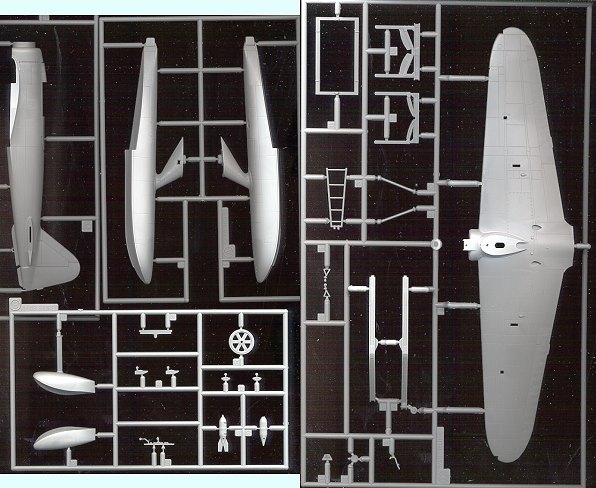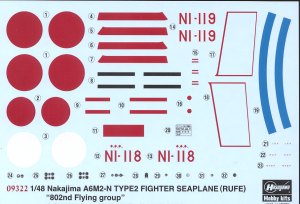
|
KIT: |
Hasegawa 1/48 A6M2-N 'Rufe' |
|
KIT # |
9322 |
|
PRICE: |
$24.95 |
|
DECALS: |
Two aircraft of 802nd Flying Group |
|
REVIEW : |
|
|
NOTES: |
"802nd Flying Group" |

|
HISTORY |
The history of the A6M Zero-Sen has been well documented in other reviews. The floatplane fighter version, Allied code-named 'Rufe' was developed by Nakajima in response to a request by the Japanese Navy for a float fighter based on the A6M2. This was mainly due to the Japanese inability to quickly build runways. There was no Japanese equivalent of the Seabees to do this. Therefore the need for defending fighters that could take off from and land on the water to defend any newly acquired ocean-front property. Like their seaplane buddies, many 'Rufe' units operated from a tender.
While a new fighter specifically designed for this purpose, the Kawanishi N1K1 'Rex' was being developed, it would be years before it was operational. Undertaking the job of converting the A6M2, Nakajima had a prototype flying in less than a year from initial development, first flying on 7 December 1941. There were 327 'Rufes' built and they saw action in nearly all theaters of the war in the Pacific, being used right up until the end of the war. The first deployment of the type was to a sleepy little bug-infested island in the Southwest Pacific called Tulagi, across a strait from a larger, even more inhospitable place that no one ever heard of called Guadalcanal.
Where enemy fighter opposition was light or weak, the 'Rufe' did well. Even against more advanced types, 'Rufe' pilots were able to score well and a few 'Rufe' pilots became aces. This particular boxing is dedicated to the pilots of the 802nd FG. The only information I have been able to find on the unit is that they were aboard the Akitsushima as their tender.
|
THE KIT |

This kit is the next to last of the new tool Zeros that Hasegawa has been working on over the last several years. The recently released A6M5 is probably the last of that line. Frankly, at this stage in the game, I seriously doubt if there will be any more new tool Zeros from anyone for a long, long, time.
 Many of the sprues
for the 'Rufe' are common to the earlier A6M2 kits that Hasegawa has produced.
However, about half of the kit is new, consisting of a new fuselage (the 'Rufe'
had a larger rudder), new lower wing, center float and stabilizing wing floats.
There is also a nice beaching trolley for you to display your new kit upon. The
new sprues are shown above. There really are two identical sprues for the wing
tip floats, but only one is shown. There are also two small bomb racks with
light bombs for additional ordnance.
Many of the sprues
for the 'Rufe' are common to the earlier A6M2 kits that Hasegawa has produced.
However, about half of the kit is new, consisting of a new fuselage (the 'Rufe'
had a larger rudder), new lower wing, center float and stabilizing wing floats.
There is also a nice beaching trolley for you to display your new kit upon. The
new sprues are shown above. There really are two identical sprues for the wing
tip floats, but only one is shown. There are also two small bomb racks with
light bombs for additional ordnance.
As one expects from Hasegawa, the molding is superb with the usual finely engraved panel lines and flash free parts. Buying an aftermarket cockpit for this kit is like gilding the lily as everything one expects is in there, similar to the Ki-84 and other newer kits. The decal sheet is quite good and provides markings for two aircraft. One is is the overall grey scheme as flown by Lt.JG Keizo Yamasaki and has three kill markings in the form of hatchets on the tail. The the other in dark black-green over grey that was used later in the war. The instruction sheet is also typical of Hasegawa in that it is superbly done with no doubt as to what part goes where.
Overall another superb Hasegawa kit and one that I will be looking forward to building.
|
REFERENCES |
Japanese Aircraft of the Pacific War, by Rene J Francillon
Camouflage and Markings of IJN Fighters, Model Art #510
Review copy courtesy of me and my wallet!
If you would like your product reviewed fairly and quickly by a site that has over 800 visits a day, please contact me or see other details in the Note to Contributors.